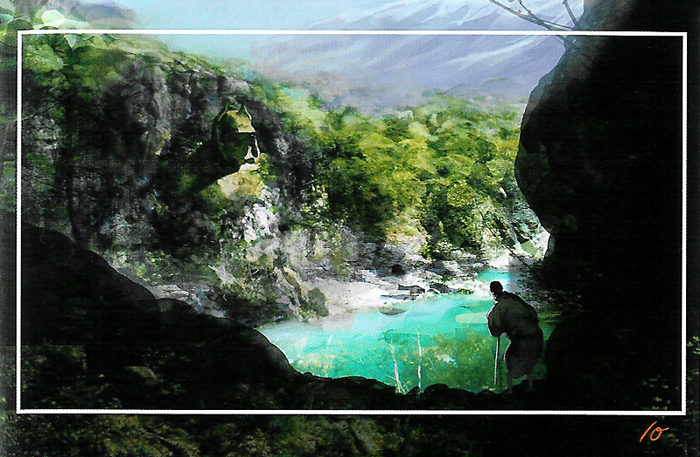An Exclusive Look at the 2010 Series with Photos and Details from Kadokawa Authors: Keith Aiken, Elizabeth Ellis and Alicia Ashby Source: Kadokawa Pictures Translations and Additional Materials: Elizabeth Ellis and Alicia Ashby Official Site: dm-kanon.com Special Thanks to Naoko Sato, Asako Suzuki and Chiyako Tasai
A SciFi JAPAN EXCLUSIVE
- History of Daimajin
- Return of Daimajin
- War Gods and Yokai
- Daimajin Girl
- Concepts and Design Works
- Special Effects
SPOILER WARNING: This article contains plot details for a recent Japanese television series not yet available in English speaking countries.
DAIMAJIN KANON is the story of Kanon Misaki, a young woman who forges through a series of dramatic changes in her life while surrounded by a menagerie of fantastic creatures... and all under the imposing presence of Daimajin. MAJIN is a Japanese period film, rich in overwhelming special effects, that was created in 1966. It tells the tale of a giant stone idol that comes to life in answer to the prayers of a young girl to save her fellow villagers from the tyranny of the local chamberlain. The unforgettable image of Daimajin who— with a piercing look in his eyes— punishes the villains, destroys the town and the chamberlain’s fortress, and moves on unchallenged and unstoppable, was received with critical acclaim and became a part of Japanese film culture. Today it stands as a symbol of a powerful and loyal guardian deity. Now Daimajin, whose name has become synonymous with overwhelming power, is making the long-awaited transition from the silver screen to television as he returns with an overhauled look. The keyword of the new Daimajin is “prayer.” In the past, “wrath” was the aspect of the Daimajin movies that attracted the greatest attention, but the new TV series puts the accent on the young girl who prays to the idol, and explores the essence of the prayer that breathes life into Daimajin. - Kadokawa Pictures publicity materials for DAIMAJIN KANON
History of Daimajin
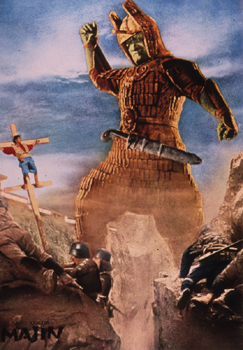 Daimajin in a colorized publicity still for the first film, MAJIN. Photo courtesy of Mill Creek Entertainment. © Kadokawa Pictures, Inc. NHFN/1966
Daimajin in a colorized publicity still for the first film, MAJIN. Photo courtesy of Mill Creek Entertainment. © Kadokawa Pictures, Inc. NHFN/1966In the mid-to-late 1960s, the Daiei Motion Picture Company produced a trio of tokusatsu (special effects) film series about giant monsters and/or supernatural creatures. The most recognized and financially successful of these, both in Japan and abroad, were the Gamera movies which launched with the original GAMERA (Daikaiju Gamera) in 1965 and followed with a new sequel every year through 1971. Daiei also made THE HUNDRED MONSTERS (Yokai Hyaku Monogatari, 1968), SPOOK WARFARE (Yokai Daisenso, 1968), and ALONG WITH GHOSTS (Tokaido Obake Dochu, 1969); three films about the strange mystical beings and apparitions from Japanese folklore known as yokai. While popular in Japan, the yokai movies were not officially available in the United States until all three were released on DVD as the “Yokai Monsters” series in 2003. Last but certainly not least was the Daimajin trilogy of MAJIN (???, Daimajin), RETURN OF MAJIN (?????, Daimajin Ikaru), and MAJIN STRIKES AGAIN (?????, Daimajin Gyakushu), which combined elements of the kaiju eiga (monster movie) genre with Daiei`s extremely popular jidai-geki (period stories) and chanbara (sword-fighting) films. Written by Tetsuro Yoshida and set during Japan`s Sengoku (Warring States) period, these three fantasy films each followed a similar pattern; telling the story of a giant statue of Daimajin (the name roughly meaning "Great Angry God") that would come to life in times of need to punish evildoers. Inspired by the German silent movie THE GOLEM (Der Golem, 1915) as well as ancient Japanese beliefs about the supernatural and the forces of nature, the Daimajin films featured high-quality special effects by Yoshiyuki Kuroda and a more serious tone than Daiei`s other FX franchises of the era. Surprisingly, all three movies were theatrically released in Japan during 1966. The first two Daimajin films were sold to distributor American International Pictures and syndicated directly to US television in 1968 as MAJIN, THE MONSTER OF TERROR and THE RETURN OF THE GIANT MAJIN. The final film in the series was not commercially available in the US until ADV Films acquired the rights to all three movies and distributed them on VHS in 1999 (and three years later on DVD). While the home video releases finally allowed American fans to see the complete series in the original Japanese with English subtitles, ADV confused the order and titles of the Majin films, naming the second movie WRATH OF DAIMAJIN and the third RETURN OF DAIMAJIN. The films` order and titles were corrected when Mill Creek Entertainment released the DAIMAJIN Triple Feature Blu-ray in September, 2012.
The Majin trilogy was created during a time of dramatic changes in the Japanese film industry. The major studios like Toho and Nikkatsu increasingly struggled against the growing popularity of television, and theater attendance dropped dramatically throughout the 1960s and into the early 1970s. Daiei still managed to produce and distribute a number of profitable movies, but was done in by executive mismanagement that drove the company to bankruptcy in late 1971. The studio was purchased by the Tokuma Shoten Publishing company in 1974 and resumed production on a much more limited scale. By the late 1980s/early 1990s, Japan`s movie business had rebounded somewhat and the studios again began to amp up production of live action FX programming. Toho`s Godzilla movies resumed after a nine year break, while Tsuburaya Pro`s Ultraman and Toei`s Kamen Rider series were returning to cinemas, home video and/or television. Daiei also began to look into reviving their own tokusatsu franchises. In 1991, the industry trade magazine Kinema Junpo revealed that Daiei was considering co-producing a new Daimajin movie with Golden Harvest Films, the Hong Kong studio behind such favorites as ENTER THE DRAGON (1973), POLICE STORY (1985), and TEENAGE MUTANT NINJA TURTLES (1990). Unfortunately, that intriguing-sounding international project never developed beyond the early news reports. Daiei shifted their attention to Gamera, bringing the monster turtle back for an acclaimed trio of films released from 1995 to 1999. In 2002, Tokuma sold Daiei to Kadokawa Shoten Publishing Co., Ltd., who merged the studio with their own film division to form the new Kadokawa Pictures. Kadokawa soon announced plans to produce new feature films based on Daiei`s classic FX franchises. Up first was the yokai update THE GREAT YOKAI WAR (Yokai Daisenso, 2005) from internationally renowned director Takashi Miike (AUDITION, ICHI THE KILLER, 13 ASSASSINS). THE GREAT YOKAI WAR was a box office hit, and the studio quickly entered into talks with Miike about directing a new Daimajin movie. But Kadokawa had much less success when they attempted to relaunch the Gamera series yet again with GAMERA THE BRAVE (Chiisaki Yusha-tachi Gamera, 2006), which brought in only $2.6 million during its domestic theatrical run. The poor turnout for GAMERA THE BRAVE and other recent daikaiju films like Toho`s GODZILLA: FINAL WARS (Gojira: Fainaru Uozu, 2004) convinced Kadokawa that Japanese moviegoers were no longer interested in the giant monster genre. Plans for Takashi Miike`s Daimajin film were canceled.
Return of Daimajin
Daimajin`s big screen revival had stalled out for a second time, but Kadokawa Pictures still had not given up on the giant idol. In April 2009, Kadokawa`s magazine Newtype The Live announced that the studio had begun work on a new venture for the guardian god: after 43 years Majin would return -- not to theaters, but in a new television series that would air late nights on TV Tokyo and affiliated stations. This show would be named DAIMAJIN KANON (??????). While post-midnight TV in the United States is often little more than a wasteland of informercials, talk shows, and reruns, Japanese stations such as TV Tokyo, NTV, TBS, and TV Asahi will often show first-run programming targeting specific demographics (college students, women, otaku, history buffs, etc). Without having to cater to a broader primetime audience, these shows have greater freedom to explore more mature themes -- which may include violence, adult humor, nudity, sex, religion, and politics -- and take more time to develop storylines and concepts gradually over several episodes. In recent years, late night Japanese programming has included a number of popular anime series, dramas (known as doramas), samurai and period shows, and cult-favorite tokusatsu productions such as ULTRA Q: DARK FANTASY (Urutora Kyuu Daaku Fantajii, 2004), GARO (2005), and ULTRASEVEN X (Urutorasebun Ekkusu, 2007).
Put in charge of Majin`s comeback were executive producer Shinichirou Inoue and producer Shigenori Takatera, two men with years of experience in their fields. Inoue had already been with Kadokawa for over a decade prior to DAIMAJIN KANON; supervising the company`s Gundam Ace magazine and producing numerous anime projects such as the .hack//SIGN television series and its various spin-offs, and also the international award-winning feature films THE GIRL WHO LEAPT THROUGH TIME (Toki o Kakeru Shojo, 2006) and SUMMER WARS (Samaa Woozu, 2009). Takatera`s background was in live action FX programming for Toei Company, starting as an assistant producer on Sentai and Kamen Rider shows like MASKED RIDER BLACK (Kamen Raidaa Burakku, 1987), KAKURANGER (Ninja Sentai Kakurenjaa, 1994), and O-RANGER (Chooriki Sentai Oorenjaa, 1995). He became head producer for a trio of influential Sentai series -- CARRANGER (Gekisoo Sentai Kaarenjaa, 1996), MEGARANGER (Denji Sentai Megarenjaa, 1997), and GINGAMAN (Seijuu Sentai Gingaman, 1998) -- which helped the franchise recover from the near-disaster caused by O-RANGER`s production issues. Shigenori Takatera next brought the Kamen Rider series into a new era with MASKED RIDER KUUGA (Kamen Raidaa Kuuga, 2000), the first Kamen Rider television series in twelve years. KUUGA made significant changes to the franchise by taking a more realistic view of the standard Kamen Rider tropes... the protagonist is not a cyborg, Kuuga does not shout out attack names, and the name "Kamen Rider" is never used in series. The revisions made under Takatera`s supervision shaped much of what the Heisei Kamen Rider franchise would become in the years to follow.
 Producer Shigenori Takatera being interviewed with Daimajin suit actor Makoto Itou. © 2009 DAIMAJIN KANON Partners
Producer Shigenori Takatera being interviewed with Daimajin suit actor Makoto Itou. © 2009 DAIMAJIN KANON PartnersTakatera`s MASKED RIDER HIBIKI (Kamen Raidaa Hibiki, 2005) was also supposed to be a "complete rebirth" for Kamen Rider; using a completely new design aesthetic for the suits, forgoing the use of the name "Kamen Rider," encouraging more natural/outdoor cinematography, employing an offbeat directorial style, and including musical segments for the first four episodes. The show also cast an already-established actor in the leading role and deviated from prior (and subsequent) Kamen Rider series by using Makoto Itou as the suit actor for the lead Rider instead of longtime performer Seiji Takaiwa. Takatera stepped down from HIBIKI after Episode 29, and following his departure much of what was unique about the series was changed to make it a more of a traditional Kamen Rider program. He would later use many of the elements of MASKED RIDER HIBIKI to better effect in DAIMAJIN KANON. Takatera has a reputation as being a very kind and charming person who is nonetheless strict on the job. Those who work with him say that the job is always "challenging, but very rewarding." The new Daimajin series reunited much of the production staff that had worked with Shigenori Takatera on the Kamen Rider and Sentai shows. Among them was director Taro Sakamoto, well known to tokusatsu fans for his work on ZYURANGER (Kyooryuu Sentai Juurenjaa, 1992), MEGARANGER, TIME RANGER (Mirai Sentai Taimurenjaa, 2000), and the Americanized series POWER RANGERS WILD FORCE (2002). He cut his teeth directing episodes of the Toei Fushigi Comedy Series (Toei Fushigi Komedii Shiriizu), a series of FX programs that ran from 1981-1993. According to an interview he did with Newtype The Live, Sakamoto had convinced Takatera to remove the musical sequences from MASKED RIDER HIBIKI, saying that he "could not see the necessity" of having them. Born in 1939, Sakamoto originally thought he might be too old for DAIMAJIN KANON, but Takatera reminded him that he was already more than 60 years old when he was asked to come to America to direct POWER RANGERS WILD FORCE back in 2001. At that time, Sakamoto`s fellow director Shouhei Toujou (RETURN OF ULTRAMAN, ZYURANGER) had turned down the same offer, saying he was "too old to learn English." But Taro Sakamoto accepted, stating "I`ll go; I`ll direct anything that`s in my power to do," and Takatera used the director`s own words to convince him to do the pilot of DAIMAJIN KANON. Taro Sakamoto would direct almost a third of the series, including the first two and last two episodes. The other directors on DAIMAJIN KANON were Norihiro Suzuki (MASKED RIDER RYUKI, MASKED RIDER 555, MASKED RIDER BLADE, MASKED RIDER HIBIKI, MASKED RIDER KABUTO), Kei Era (TOMICA HERO RESCUE FORCE), Takuji Kitamura (NEGATIVE HAPPY CHAINSAW EDGE), and Atsushi Shimizu (ULTRA Q: DARK FANTASY, TEN NIGHTS OF DREAMS).
Shinji Ooishi was named series planner and head writer for DAIMAJIN KANON. He had been one of the screenwriters for MASKED RIDER HIBIKI, but was replaced following Shigenori Takatera`s departure. Ooishi was involved in developing DAIMAJIN KANON`s basic concept and characters, and also wrote or co-wrote ten of the twenty-six episodes, including the first four and last four of the series. Seven episodes were written by Naruhisa Arakawa. Arakawa`s first tokusatsu writing assignment was for an episode of MASKED RIDER BLACK, and he would go on to become lead writer on the Sentai series ABA RANGER (Bakuryuu Sentai Abarenjaa, 2003) and DEKA RANGER (Tokusoo Sentai Dekarenjaa, 2004). He handled series composition on MASKED RIDER KUUGA and is also the head writer on the Sentai 35th anniversary series, GOKAIGER (Kaizoku Sentai Gookaijaa, 2011). The remaining DAIMAJIN KANON scripts were split up among a team of writers that included Ai Sumikawa, Shinsuke Onishi (KIKAIDER: THE ANIMATION, ULTRAMAN TIGA through ULTRAMAN COSMOS), and Miyuki Sekiguchi. The music for DAIMAJIN KANON was created by famed composer Toshihiko Sahashi. Sahashi`s credits include the soundtracks for dozens of popular anime and tokusatsu series and movies such as ULTRAMAN: THE ULTIMATE HERO (Urutoraman Pawaado, 1993), ULTRAMAN GAIA (Urutoraman Gaia, 1998), MASKED RIDER KUUGA, MASKED RIDER AGITO (Kamen Raidaa Agito, 2001), MOBILE SUIT GUNDAM SEED (Kidoo Senshi Gandamu Shiido, 2002), GUNDAM SEED: DESTINY (Kidoo Senshi Gandamu Shiido Desutinii, 2004), MASKED RIDER HIBIKI, ULTRAMAN MEBIUS (Urutoraman Mebiusu, 2006), ULTRAMAN MEBIUS & ULTRAMAN BROTHERS (Urutoraman Mebiusu & Urutora Kyoodai, 2006), and MASKED RIDER DEN-O (Kamen Raidaa Den-oo, 2007).
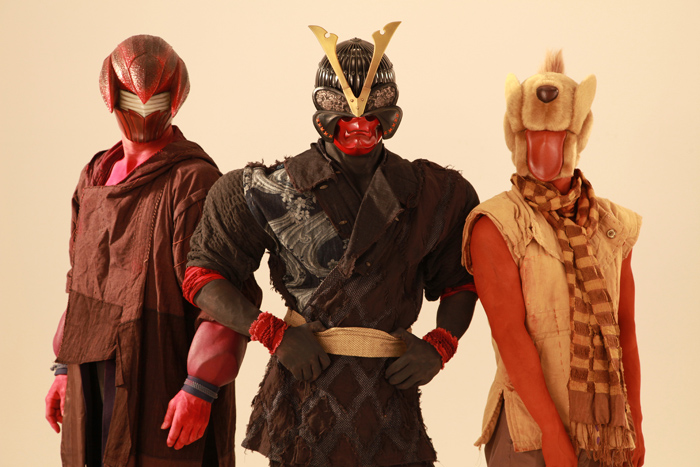 The Onbake heroes Sawamori, Taihei, and Tomosuke. Photo courtesy of Kadokawa Pictures, Inc. © 2009 DAIMAJIN KANON Partners
The Onbake heroes Sawamori, Taihei, and Tomosuke. Photo courtesy of Kadokawa Pictures, Inc. © 2009 DAIMAJIN KANON PartnersWar Gods and Yokai
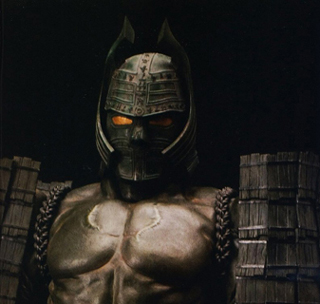 Daimajin`s role in the series was a major story issue for the show`s producers. © 2009 DAIMAJIN KANON Partners
Daimajin`s role in the series was a major story issue for the show`s producers. © 2009 DAIMAJIN KANON PartnersWhile DAIMAJIN KANON was officially announced by Kadokawa in April of 2009, the project had been quietly in development for well over a year prior. The extended pre-production schedule gave Shinichirou Inoue, Shigenori Takatera, and their crew time to work out a number of different concepts for the series long before the cameras would roll. One of the most important decisions faced by the creative team was how to best present the character of Daimajin to a modern television audience. Back in the 1960s Daiei had maintained a basic formula for the Majin movies that was quite different from the other kaiju eiga. One clear difference was that MAJIN and its sequels took place hundreds of years in the past rather than the current or near-future settings used for most Japanese monster movies. But DAIMAJIN KANON would break with that tradition and be set in the modern day, allowing the show`s crew to take a fresh approach to the Majin story. Another key element of the Daimajin films was that the title character -- while a constant presence in the background of each story -- appears onscreen only briefly. Instead, the majority of each film dealt with the human protagonists who are suffering under and struggling against the oppressive rule of an evil warlord. Only when things take a final turn for the worse in the third act does Daimajin awaken in answer to the prayers of the heroes or the misdeeds of the villains. In a marked contrast from the formats of FX franchises like Ultraman and Kamen Rider, the makers of DAIMAJIN KANON decided to follow the basic pattern of the original films by having the story focus on the characters who attempt to awaken Daimajin in order to stop a growing evil. Daimajin would occasionally appear in the series via flashbacks, dreams, or visions, but only come back to life as the series neared its conclusion.
The choice to have the series slowly build up to Daimajin`s return was a risky one, and it required the main characters to be interesting and entertaining enough on their own to hold the audience`s attention over the course of twenty or more episodes. The creative team cleverly accomplished that objective by tying DAIMAJIN KANON to another of Kadokawa`s old Daiei tokusatsu franchises... most of the show`s protagonists would be yokai rather than everyday people. The yokai in DAIMAJIN KANON are of a very specific type known as "Onbake". Their name derived from the kanji for "on" (gratitude) and "bakeru" (transform), the Onbake are animals, places, or inanimate objects that were given new life by the love and care shown to them by human beings. These yokai exist out of their gratitude to humans, and they happily make it their job to protect people. They come in all manner of shapes and sizes, with many having both a human form and an Onbake form that reflects their origins. DAIMAJIN KANON features Onbake who were incarnated from a samurai helmet, a dog, a crayfish, a hawk, a cauldron, a goldfish, and even a television set. While possibly an odd concept for Westerners to grasp, the Onbake would be easily understood by Japanese audiences familiar with the classic yokai tales and legends or more modern interpretations such as the Daiei/Kadokawa yokai films, Shigeru Mizuki`s popular manga GeGeGe No Kitaro and it`s spin-offs, or Hayao Miyazaki`s blockbuster anime film SPIRITED AWAY (Sen to Chihiro no Kamikakushi, 2001).
But equally familiar in both East and West is the idea of a great evil or malice that continues to exist after death. This concept has been at the heart of countless ghost stories as well as Japanese horror film franchise such as THE RING and JU-ON/THE GRUDGE that have been successfully adapted for American audiences. It is also used as the basis for the Ipadada, the villains of DAIMAJIN KANON. When a human dies with a deep grudge or need for vengeance, that person may be reincarnated as an evil spirit known as an Ipadada. This cycle repeats every twelve years or so. Once reborn, the Ipadada would possess a human body in order to kill victims and absorb their souls. If an Ipadada is able to consume one hundred souls it becomes a gigantic, monstrous Great Ipadada that causes widespread death and destruction. The Onbake are the sworn enemies of the Ipadada, and they work to stop the evil spirit before it can reach full power. But if the Ipadada reaches that final stage, the Great Ipadada can only be destroyed by Daimajin. The producers` approach to the characters and story of DAIMAJIN KANON created some unique opportunities for action director Tatsuro Koike. A stunt coordinator and second unit director with credits both in the United States (DAREDEVIL, LAST SAMURAI, JUMPER) and Japan (K-20: THE FIEND WITH TWENTY FACES), Koike described the filming of a battle between the Onabke Sawamori and Kotaro, a human possessed by the Ipadada, in Episode 1...
"We thought those expecting the action of a tokusatsu might be a a little shocked by the scene. We went with the concept of using no superfluous movements, and keeping it to movements that humans could do, so we didn`t use any slow motion. No explosions, either. We thought about putting in some flashy roundhouse kicks to make it a better show, but ultimately decided that would be out of character for these two. We`ve heard people say that it`s almost subdued. We knew we`d get that sort of resistance to it, of course... but I don`t think it`s a good thing if everyone likes your work, anyway. Personally, I`m very satisfied by the scene." Koike was also pleased by a stunt involving Kotaro and Sawamori leaping from a parking garage. "We presented this as a one-cut...the stuntmen actually took the fall, and we removed the mat through composite imagery. Others in this business might be impressed by the shot, but it`s a little painful that modern viewers would think we did it with CGI [laughs]. But I think doing it with real actors gives it more impact, so I really wanted to do it this way. The Japanese record for a fall like this is 40 meters, so I wanted to challenge it by doing a 50-meter drop, but we weren`t able to do it. I think if we had managed that, we could have made a legend [laughs]. In reality, we had Kotaro fall 15 meters, and Sawamori fall about 18 meters. In Japan, 10 meters is about what you need for something to feel "high," but in America, we use 45 meter falls as warming up, so the perceptions are very different. So for us, it was like `We can do 12 meters in our sleep!` Sawamori actually twisted his leg doing the fall. I guess that`s what makes it different from superheroics..."
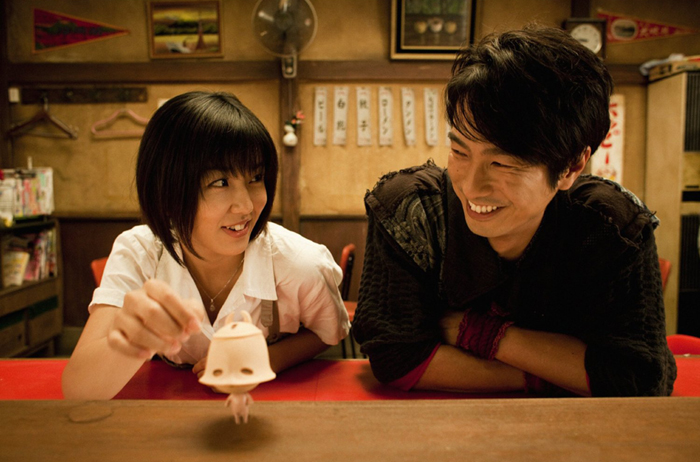 Kanon Misaki and Taihei -- the human and yokai leads of DAIMAJIN KANON -- with the tiny Onbake Buchinko. © 2009 DAIMAJIN KANON Partners
Kanon Misaki and Taihei -- the human and yokai leads of DAIMAJIN KANON -- with the tiny Onbake Buchinko. © 2009 DAIMAJIN KANON PartnersDaimajin Girl
Shigenori Takatera and Shinichirou Inoue wanted the Daimajin/Onbake storyline to be intertwined with what they saw as the true heart of the series: the personal growth of a troubled young person who is thrown into unusual circumstances. The two producers gave a great deal of thought to the lead human character of the series and eventually decide that character would be a young woman.
Takatera recalled that, "When I was filming HIBIKI, there were opinions that Asumu [the young boy protagonist of the show] needed to team up with Hibiki as soon as possible. `Asumu is his student, so he should fight,` they said. I wanted to avoid that viewpoint this time, so when thinking of ways to figure out how to circumvent this, I realized that if I made the protagonist a woman, people would be less likely to insist that she fight. Since the main story I wanted to tell was that of a young person`s growth, I didn`t want the secondary thread of battle hero action to supersede that." Developing the lead character in this manner was seen by some members of the DAIMAJIN KANON crew as a cathartic experience for Shigenori Takatera that allowed the producer to recover from the ordeal of HIBIKI while creating a new and more beautiful work. Executive producer Shinichirou Inoue even directly compared Kanon to Takatera in an interview for the first DAIMAJIN KANON Blu-ray set. An additional benefit from Takatera`s decision was that it fulfilled a mandate from Kadokawa that he had been struggling with. Based on the recent crossover success of titles like THE GIRL WHO LEAPT THROUGH TIME, the company felt that the new Daimajin should also appeal to the large female audience that routinely purchased Kadokawa books, anime, and manga. A female protagonist would give the series the "Kadokawa Shoten" feel the company wanted. In Takatera`s notes from as far back as late April 2008 the main character is named Shinobu and described as a woman "raised with high ideals, but battered by the waves of an unforgiving society" whose misfortunes have caused her to distrust others and develop a bit of a vindictive streak. Also identified is Shinobu`s friend, Taku, "a free-spirited man who seeks coexistence with others and liberates her heart." But before long, Taku was phased out of the planning documents in favor of a new character named Taihei. With the addition of Taihei, the project began evolving into its final form.
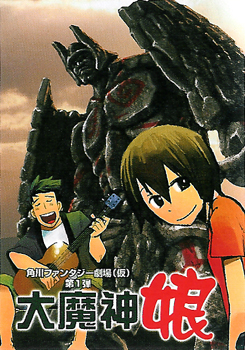 Suzuki Konami Daimajin Musume manga art with the characters Taku, Shinobu and the wooden Daimajin. © 2009 DAIMAJIN KANON Partners
Suzuki Konami Daimajin Musume manga art with the characters Taku, Shinobu and the wooden Daimajin. © 2009 DAIMAJIN KANON PartnersWith the story developing into something quite different from previous Daimajin projects, the producers decided to explain it in a very "Kadokawa Shoten" way... as a manga. Written and drawn by Suzuki Konami -- who also created the character designs -- the Daimajin Musume (????, meaning "Daimajin Girl") manga revealed many of the characters and concepts considered during the early stages of production for the new Daimajin. The central character was still known as "Shinobu" at this point, but her backstory was now fairly similar to what would be seen in DAIMAJIN KANON; an innocent college girl who has been emotionally wounded and lost her song since coming to Tokyo. The Onbake were still known as "Yokai." In personality and appearance, Taihei is roughly the same character. Another Onbake known as Totohime would be renamed Ikechiyo for the series. And Kotaro is featured in Daimajin Musume in something close to his modern form -- as Kanon`s ex-boyfriend who wounds her out of selfishness -- but did not appear to be possessed or a major antagonist as he is in the show. Perhaps the biggest difference between the manga and television series was the Daimajin Musume villain, Dokuromi, a computer yokai and "evil schemer" type of character who apparently manipulates Shinobu`s co-worker, a stalker named Eiichi. In the manga, Dokuromi abducts Shonobu in an attempt to revive Daimajin for nefarious purposes. Another change from DAIMAJIN KANON was that Daimajin was awakened from a great tree, rather than being a stone giant. When it came to selecting the cast of DAIMAJIN KANON, Takatera`s policy was to not use any actors with prior experience in "hero shows". And after the headaches he`d dealt with on GINGAMAN, Takatera decided it would be easier to hire actors with a similar worldview to their character rather than trying to coax a naturalistic performance out of someone who may not be suited for their role.
For Kanon Misaki, the producers knew they wanted "a pure, clumsy girl who had known heartbreak before." More than a thousand women tried out for the part, and Takatera admitted there was some pressure in the auditions after the luck they`d had casting the lead for MASKED RIDER KUUGA. "Would we find another Joe Odagiri?", he wondered. The auditions for Kanon included a singing test, for which the producers chose Kyu Sakamoto`s "Ue o Muite Arukou" (Looking Up As I Walk), the 1963 international hit that topped the US Billboard Charts as "Sukiyaki". After the song, each actress hopeful was asked they regretted most in their life. Takatera recalled that, "Most of the people who answered related a story about saying harsh words to the person closest to them, and then eventually breaking up. About 90% of the girls who answered that way immediately burst out crying. It wasn`t at all what we expected." In the end, Yuka Rikuna was chosen for the role. Initially considered somewhat of a dark horse -- she was described as "someone who should be a friend to the protagonist rather than the protagonist herself" -- Rikuna impressed the producers with her sincerity and concern for the well being of others. When asked the question about her greatest regret, she answered the question as well as she could despite crying so hard she couldn`t stop. "She seemed sort of sweet, sort of earnest, had almost a child-like purity, and she was always talking about her family," Takatera explained. "It was clear that her family meant a lot to her."
Takatera`s "no hero show actors" policy went out the window with the casting of Nao Nagasawa (formerly Hurricane Blue) as Ikechiyo and, later, Shouhei Izumi (formerly Time Yellow) as Kaenji. Hidekazu Mashima (Taihei) and Takashi Yamanaka (Tomosuke) were from the same talent agency and auditioned on the same day. Yamanaka went first and then waited for Mashima to finish so that they could walk back to the train station together. "Watching them together, they almost had an air of R2-D2 and C-3PO about them, and I could easily see them as Taihei and Tomosuke," Takatera recalled. The producers offered a bit of "fan service" by casting J-Idols and gravure models like Serina Ogawa (as the falcon Onbake Hashitaka) and race queen Sayuki Matsumoto (as the mantis Onbake Kirinoha). Along with Nao Nagasawa, the models were profiled in the DAIMAJIN KANON tie-in book, Daimajin Girlfriend ?Nao Nagasawa, Serina Ogawa, Sayuki Matsumoto Photo Collection? (??????? ?????????????????Photo Collection?), published by Newtype. Director Taro Sakamoto also had a hand in selecting the DAIMAJIN KANON cast. Nagato Hiroyuki (Jyuzo) had first worked with Sakamoto in 1985 on the set of SUKEBAN KEIJI, and was relieved that he was being directed by "A fellow old man" instead of a younger director. Sakamoto had directed actress Shibata Rie (Otaki) on the Fushigi Comedy series MAGICAL GIRL CHUKANA PAI-PAI (1989); Rie was having trouble fitting DAIMAJIN KANON into her busy schedule but decided to make time when she learned that her old friend was directing.
Concepts and Design Works
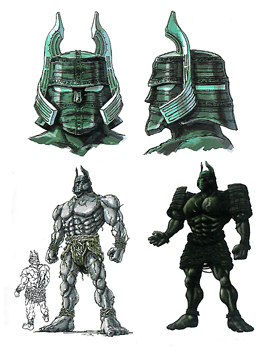 Top: Daimajin head designs based off a sketch by Takatera. Bottom: Full-body design and a representation of an idea that ancient humans made plate armor for Daimajin`s shoulders and hips. The basic silhouette was used in the final Daimajin design. © 2009 DAIMAJIN KANON Partners
Top: Daimajin head designs based off a sketch by Takatera. Bottom: Full-body design and a representation of an idea that ancient humans made plate armor for Daimajin`s shoulders and hips. The basic silhouette was used in the final Daimajin design. © 2009 DAIMAJIN KANON PartnersAs planning went on, so did the character design process. With the concept of the Onbake as "objects and animals incarnated through human love" locked in place, the artists began experimenting with the rules of their design. The designers kept in mind Shigenori Takatera`s instructions that the characters should always have a "living" quality to them, regardless of their origins. A number of artists -- both independent contractors and those on the DAIMAJIN KANON staff -- submitted designs for the new Daimajin, some even before preliminary discussions regarding the character had taken place. Early on, the crew was leaning towards the depiction of Daimajin as a soldier with a somewhat wooden appearance who has turned into a giant tree. But then it was proposed that, since Taihei and the other Onbake were incarnated from objects, Daimajin might also be a yokai incarnated from something. From that point, the producers and artists started designing Daimajin as being based off a dotaku, a ritual bronze bell from the Yayoi Period (300 BC to 300 AD). The first Taihei designs were done by Tetsuya Aoki from PLEX, a design firm subsidiary of Namco Bandai (one of the companies partnering with Kadokawa on DAIMAJIN KANON). Aoki -- who had previously created designs for the original Transformers -- expanded on the outline of the series he was given, with his take on Taihei drawing heavily from Daimajin`s design. The "full-armored version" earned such high praise from the crew that, even after the design development went in a different direction, plans remained to give Taihei two brothers made from a sword and a suit of armor, who would unite to form "Armor Taihei". While this idea was abandoned for the show, it was later used in writer/artist Seijuro Mizu`s Daimajin Kanon manga (serialized in Kadokawa`s Young Ace magazine).
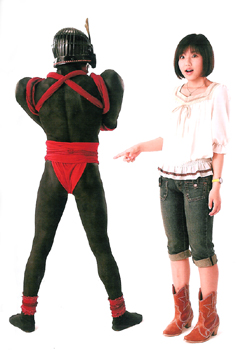 Yuka Rikuna is shocked -- but pleased -- to see Taihei wearing only a fundoshi. © 2009 DAIMAJIN KANON Partners
Yuka Rikuna is shocked -- but pleased -- to see Taihei wearing only a fundoshi. © 2009 DAIMAJIN KANON PartnersTakatera sketched designs for Taihei`s head that incorporated clearly defined eyes and a moving mouth, all in keeping with his view that the Onbake designs should have a living quality to them. Another of Takatera`s head designs was inspired by a kabuto helmet seen in a car commercial. For this version, the "side flaps" on either side of the helmet stood out to the eyes, forming the image of a face. All of the Taihei designs that followed maintained this basic look. Lead concept artist Shinji Ooishi drew a handful of variations of the Taihei head design. At one point, Takatera added a nose to make the character look a bit more human, but this idea was quickly dropped. After several revisions, a final head design was approved and went into the clay-molding phase. Ooishi was worried that Taiehei might end up becoming too much of a stereotypical action hero if they went with the armored design. So he decided to try drawing a full-body design of a "naked version" of Taihei wearing only a fundoshi, a traditional Japanese loincloth. Based on Ooishi`s design, the crew decided that, for all of the Onbake, the head portion would carry the essence of the original object or animal. The human-like body would be an extension that would grow out from the yokai`s head. As Taihei`s design evolved, Tetsuya Aoki proposed the idea of giving the character enlarged muscular protrusions at his shoulders, chest and femurs. The designers also considered imprinting Taihei with body paint and tattoo-like patterns to hide the seams between the the suit actor`s body and any prosthetic appliances. For Taihei`s final design, the seams were covered by various forms of wrapped cloth.
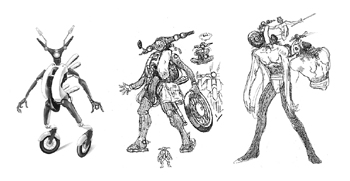 Designs by Fukuchi and Aoki for an abandoned character; a yokai version of Taihei`s motorcycle. © 2009 DAIMAJIN KANON Partners
Designs by Fukuchi and Aoki for an abandoned character; a yokai version of Taihei`s motorcycle. © 2009 DAIMAJIN KANON PartnersIn the early planning stages, Taihei`s bike was also going to be a yokai. The preliminary drafts of the scripts for the first two episodes described the character as a talking motorcycle. The screenwriters reportedly liked the motorcycle yokai and had a difficult time abandoning a scene from Episode 1 where it accelerates into a big jump. The character was conceptualized as a CG character, and several designs were drawn up by Hitoshi Fukuchi and Tetsuya Aoki. After it was decided that the head portions were the "real" yokai, Fukuchi drew up a design in which the the head itself was the bike, and a large humanoid body would grow out from underneath it. This concept was planned to first appear around the middle of the series, but was eventually dropped. In addition to his work on Taihei and the motorbike yokai, Tetsuya Aoki also submitted the initial designs for the female Onbake, Totohime/Ikechiyo. Aoki`s artwork depicted both a bird-version of the character as well as the goldfish-version (another version based on a carp was also considered). For some of the yokai designs, "deformed" silhouettes evocative of the works of Hong Kong figure artist Michael Lau were proposed. Lau`s art also influenced the color tests for the Onbake. The design team latched onto the concept that the fantastical characters would be two-tone, and several two-color designs were tried for Taihei and the other yokai.
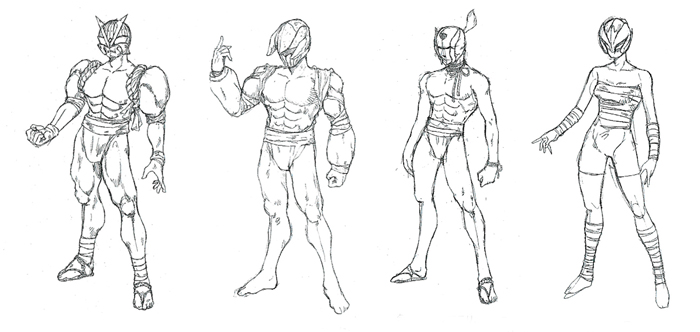 Final designs from January 2009 for Taihei, Sawamori, Tomosuke, and Hashitaka. At this stage, Sawamori was temporarily named
Final designs from January 2009 for Taihei, Sawamori, Tomosuke, and Hashitaka. At this stage, Sawamori was temporarily named Special Effects
In the earliest stages of DAIMAJIN KANON, Kadokawa formed a partnership with a handful of companies to help defray costs and share in the development, production and marketing of the series. Known collectively as the DAIMAJIN KANON Partners, the group included TV Tokyo, the video game and toy giant Bandai Co., the international consulting firm T.Y.Entertainment, the film and video production company Omnibus Japan, the production house Dogsugar, the otaku clothing brand Cospa, and the mobile operator NTT DoCoMo Inc. This partnership provided DAIMAJIN KANON with the highest budget to date for a Japanese dorama. Originally set at ¥500 million (approximately $6 million US) it was eventually doubled to ¥1 billion (approximately $12 million US), or more than $450,000 per episode. This amount was nearly five times the budget for a typical late night series.
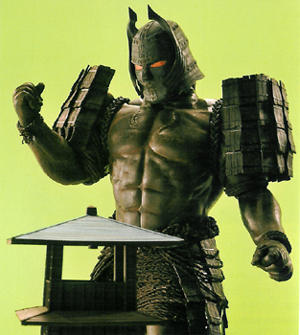 Daimajin stands next to a miniature watchtower in a green screen shot by FX supervisor Toshio Miike. This would be combined with additional elements such as fleeing people and a CGI Ipadada. © 2009 DAIMAJIN KANON Partners
Daimajin stands next to a miniature watchtower in a green screen shot by FX supervisor Toshio Miike. This would be combined with additional elements such as fleeing people and a CGI Ipadada. © 2009 DAIMAJIN KANON PartnersDAIMAJIN KANON was originally scheduled to debut on TV Tokyo in October 2009, but was eventually postponed to start in April 2010. The series began production on June 2nd, 2009, with principal photography lasting for seven months, wrapping on December 20th that same year. Special Effects for DAIMAJIN KANON were supervised by Toshio Miike. A highly-regarded art director, production designer and FX supervisor, Miike`s credits include the Toho sci-fi film GUNHED (Ganheedo, 1989), ZEIRAM (Zeiramu, 1991), several Godzilla films from KING GHIDORAH to FINAL WARS, the 1990s Gamera trilogy, Quentin Tarantino`s KILL BILL VOL. 1 (2003), SINKING OF JAPAN (Nihon Chinbotsu, 2006) and ULTRAMAN SAGA (Urutoraman Saaga, 2012). All of the creature suits, props, and animatronics were created by Monsters, Inc., the effects house owned and run by Shinichi Wakasa. Wakasa started as his professional career on Kinji Fukusaku`s cult classic MESSAGE FROM SPACE (Uchukara-no Messeji, 1978) and has worked on a wide variety of film and television projects, including Tsuburaya Productions` ULTRAMAN TIGA (Urutoraman Tiga, 1996) and ULTRAMAN COSMOS (Urutoraman Kosumosu, 2001) television series, GAMERA 2: ATTACK OF LEGION (Gamera 2 Legion Shurai, 1996), PYROKINESIS (Kurosufaia, 2000) and DEVILMAN (Debiruman, 2004). Wakasa also produced more than half of Toho`s monsters since 1993, including the Godzilla suits and props for GODZILLA 2000 (Gojira Ni-sen Mireniamu, 1999) and four of the next five films through GODZILLA: FINAL WARS. The visual effects for DAIMAJIN KANON were produced by the computer graphics and post-production house Omnibus Japan. Omnibus` long list of credits includes UMIZARU EVOLUTION (2005), GARO, EVANGELION: 1.0 YOU ARE (NOT) ALONE (Evangelion Shin Gekijoban: Jo, 2007), PACO AND THE MAGICAL BOOK (Pako to Maho no Ehon, 2008), DETROIT METAL CITY (2008), KAIJI: THE ULTIMATE GAMBLER (Kaiji: Jinsei Gyakuten Gemu, 2009), SPACE BATTLESHIP YAMATO: RESURRECTION (Uchu Senkan Yamato: Fukkatsu Hen, 2010), and GARO THE MOVIE 3D: RED REQUIEM (2010). The video production company Kurofune Products also worked on CGI modeling and animation, matte art and compositing for the series. Kurofune`s credits included a number of music videos, title sequences for TV programs, video games and the Tsuburaya Pro series BIO PLANET WOO (Seibutsu Suisei Woo, 2006) and ULTRA GALAXY: MEGA MONSTER BATTLE (Urutora Gyarakushii Daikaiju Batoru, 2007).
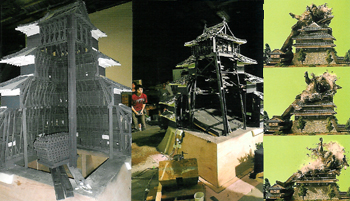 Interior views of Matsumoto Castle miniature, constructed by Marbling Fine Arts. The miniature was designed and built to be destroyed by the falling Daimajin. © 2009 DAIMAJIN KANON Partners
Interior views of Matsumoto Castle miniature, constructed by Marbling Fine Arts. The miniature was designed and built to be destroyed by the falling Daimajin. © 2009 DAIMAJIN KANON PartnersThe creation of the special effects sequences would require the combined efforts of technicians and craftsmen from each of these companies. The miniatures -- including a large recreation of Matsumoto Castle -- would often begin as designs sketched by Toshio Miike. From there, the structures would be built by Marbling Fine Arts, the Tokyo-based company behind 90% of the miniature effects in modern Japanese cinema. If a miniature was to be destroyed onscreen, it would be constructed of materials like balsa wood or plaster that would break easily, with no internal framework. On set, the practical effects team may spend an entire work day prepping a miniature, cutting breakaway slits into it and then obscuring the gaps with putty. In some cases, veteran technician Hiroyuki Hatori would add gunpowder to the miniatures to aid in their destruction and create smoke rising from the debris. The miniature effects would be combined with a variety of additional elements -- actors and extras filmed in front of a green screen, stunt actor Makoto Itou in the Daimajin suit, computer generated effects and characters (including the Ipadada), etc -- for a completed shot. One of the key set pieces for the series was Daimajin`s resting place, Bujin Rock, which combined miniature and location elements. The look of Bujin Rock started with storyboards and concept art drawn by Shigeru Okuyama and Yuusuke Kubo. Using the artwork as a guide, location scouts selected Ryuuozaka in Ibaraki Prefecture to represent the site. A miniature of Bujin Rock was created by Shinichi Wakasa`s Monsters Inc., while a surrounding cliff face that would blend with the location footage was built by Miike and the SFX art staff. Composite shots are usually filmed against a green screen, but the green would blend with the color of the trees on location so a blue screen was used, instead. The location footage would also be enhanced it different ways... for example, the staff filmed a miniature waterfall made of pouring sand and blended it with a real waterfall shot at Ryuuozaka. Using a system developed by Omnibus Japan, the directors were able to make temporary composite shots during filming. This process greatly increased the quality of blended elements. "Being able to view the composite shots during filming was a huge help," Toshio Miike explained. "Before now, we would film several takes just to make sure we had what we need, and that took a lot of time. Being able to see it and correct it on the spot greatly increased the accuracy with which we could film the materials."
About Kadokawa Pictures
Kadokawa Pictures, a division of Japanese entertainment giant Kadokawa Holdings, Inc., develops, finances, produces and distributes live action and anime films theatrically and for TV throughout Japan and Asia and boasts a state-of-the art production facility in Tokyo. Films that have garnered worldwide attention from Kadokawa`s library of over 2,000 titles include THE RING, DARK WATER, PULSE and SHALL WE DANCE? Coming Soon! DAIMAJIN KANON Series Guide Part 2: Characters and Cast, Episode Guide, and Credits
For more information on Daimajin please see the earlier coverage here on SciFi Japan:
- Daiei`s Idol of Terror: DAIMAJIN, THE AVENGING GOD
- A Double Dose of Takashi Miike News
- Upcoming Products: SCI-FI REVOLTECH SERIES
- Daimajin Trilogy Coming to US Blu-ray
- GAMERA 3 and GAMERA TRILOGY Blu-ray Updates
- DAIMAJIN Triple Feature Collector`s Edition Blu-ray in September
- DAIMAJIN Triple Feature Blu-ray Final Cover Art Revealed
- DAIMAJIN Triple Feature Blu-ray Trailer
- Win DAIMAJIN Triple Feature Collector`s Edition Blu-ray Sets!










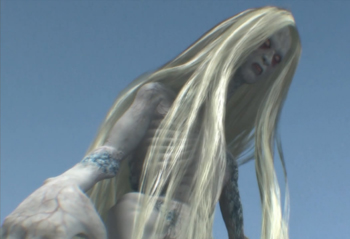



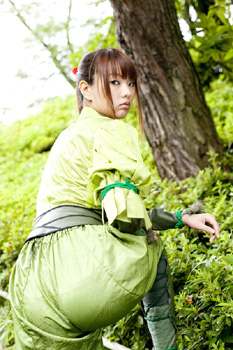
 From left to right: the Super Cub yokai Kabuzo, Taihei, the goldfish yokai Totohime, the boys` day doll yokai Kinta, the scarf yokai Hirari, the wise television yokai Zatere, stone lantern yokai Jiji, the money safe yokai Kaneban, the umbrella yokai Kasayan, and the rice pot yokai Ookama. © 2009 DAIMAJIN KANON Partners"/>
From left to right: the Super Cub yokai Kabuzo, Taihei, the goldfish yokai Totohime, the boys` day doll yokai Kinta, the scarf yokai Hirari, the wise television yokai Zatere, stone lantern yokai Jiji, the money safe yokai Kaneban, the umbrella yokai Kasayan, and the rice pot yokai Ookama. © 2009 DAIMAJIN KANON Partners"/>